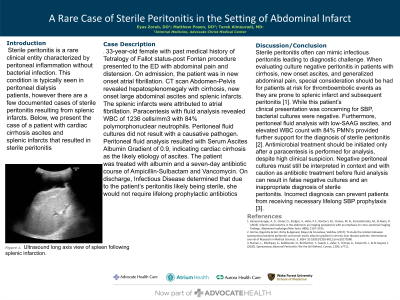Monday Poster Session
Category: Liver
P3029 - A Rare Case of Sterile Peritonitis in the Setting of Abdominal Infarct
Monday, October 28, 2024
10:30 AM - 4:00 PM ET
Location: Exhibit Hall E

Has Audio
- EZ
Eyas Zorub, DO
Advocate Christ Medical Center
Oak Lawn, IL
Presenting Author(s)
Eyas Zorub, DO, Matthew Posen, DO, Tarek Almouradi, MD
Advocate Christ Medical Center, Oak Lawn, IL
Introduction: Sterile peritonitis is a rare clinical entity characterized by peritoneal inflammation without bacterial infection. This condition is typically seen in peritoneal dialysis patients, however there are a few documented cases of sterile peritonitis resulting from splenic infarcts. Below, we present the case of a patient with cardiac cirrhosis ascites and splenic infarcts that resulted in sterile peritonitis.
Case Description/Methods: A 33-year-old female with past medical history of Tetralogy of Fallot status-post Fontan procedure presented to the ED with abdominal pain and distension. On admission, the patient was in new onset atrial fibrillation. CT scan Abdomen-Pelvis revealed hepatosplenomegaly with cirrhosis, new onset large abdominal ascites and splenic infarcts. The splenic infarcts were attributed to atrial fibrillation. Paracentesis with fluid analysis revealed WBC of 1236 cells/mm3 with 84% polymorphonuclear neutrophils. Peritoneal fluid cultures did not result with a causative pathogen. Peritoneal fluid analysis resulted with Serum Ascites Albumin Gradient of 0.9, indicating cardiac cirrhosis as the likely etiology of ascites. The patient was treated with albumin and a seven-day antibiotic course of Ampicillin-Sulbactam and Vancomycin. On discharge, Infectious Disease determined that due to the patient’s peritonitis likely being sterile, she would not require lifelong prophylactic antibiotics.
Discussion: Sterile peritonitis often can mimic infectious peritonitis leading to diagnostic challenge. When evaluating culture negative peritonitis in patients with cirrhosis, new onset ascites, and generalized abdominal pain, special consideration should be had for patients at risk for thromboembolic events as they are prone to splenic infarct and subsequent peritonitis [1]. While this patient’s clinical presentation was concerning for SBP, bacterial cultures were negative. Furthermore, peritoneal fluid analysis with low-SAAG ascites, and elevated WBC count with 84% PMN’s provided further support for the diagnosis of sterile peritonitis [2]. Antimicrobial treatment should be initiated only after a paracentesis is performed for analysis, despite high clinical suspicion. Negative peritoneal cultures must still be interpreted in context and with caution as antibiotic treatment before fluid analysis can result in false negative cultures and an inappropriate diagnosis of sterile peritonitis. Incorrect diagnosis can prevent patients from receiving necessary lifelong SBP prophylaxis [3].
Disclosures:
Eyas Zorub, DO, Matthew Posen, DO, Tarek Almouradi, MD. P3029 - A Rare Case of Sterile Peritonitis in the Setting of Abdominal Infarct, ACG 2024 Annual Scientific Meeting Abstracts. Philadelphia, PA: American College of Gastroenterology.
Advocate Christ Medical Center, Oak Lawn, IL
Introduction: Sterile peritonitis is a rare clinical entity characterized by peritoneal inflammation without bacterial infection. This condition is typically seen in peritoneal dialysis patients, however there are a few documented cases of sterile peritonitis resulting from splenic infarcts. Below, we present the case of a patient with cardiac cirrhosis ascites and splenic infarcts that resulted in sterile peritonitis.
Case Description/Methods: A 33-year-old female with past medical history of Tetralogy of Fallot status-post Fontan procedure presented to the ED with abdominal pain and distension. On admission, the patient was in new onset atrial fibrillation. CT scan Abdomen-Pelvis revealed hepatosplenomegaly with cirrhosis, new onset large abdominal ascites and splenic infarcts. The splenic infarcts were attributed to atrial fibrillation. Paracentesis with fluid analysis revealed WBC of 1236 cells/mm3 with 84% polymorphonuclear neutrophils. Peritoneal fluid cultures did not result with a causative pathogen. Peritoneal fluid analysis resulted with Serum Ascites Albumin Gradient of 0.9, indicating cardiac cirrhosis as the likely etiology of ascites. The patient was treated with albumin and a seven-day antibiotic course of Ampicillin-Sulbactam and Vancomycin. On discharge, Infectious Disease determined that due to the patient’s peritonitis likely being sterile, she would not require lifelong prophylactic antibiotics.
Discussion: Sterile peritonitis often can mimic infectious peritonitis leading to diagnostic challenge. When evaluating culture negative peritonitis in patients with cirrhosis, new onset ascites, and generalized abdominal pain, special consideration should be had for patients at risk for thromboembolic events as they are prone to splenic infarct and subsequent peritonitis [1]. While this patient’s clinical presentation was concerning for SBP, bacterial cultures were negative. Furthermore, peritoneal fluid analysis with low-SAAG ascites, and elevated WBC count with 84% PMN’s provided further support for the diagnosis of sterile peritonitis [2]. Antimicrobial treatment should be initiated only after a paracentesis is performed for analysis, despite high clinical suspicion. Negative peritoneal cultures must still be interpreted in context and with caution as antibiotic treatment before fluid analysis can result in false negative cultures and an inappropriate diagnosis of sterile peritonitis. Incorrect diagnosis can prevent patients from receiving necessary lifelong SBP prophylaxis [3].
Disclosures:
Eyas Zorub indicated no relevant financial relationships.
Matthew Posen indicated no relevant financial relationships.
Tarek Almouradi indicated no relevant financial relationships.
Eyas Zorub, DO, Matthew Posen, DO, Tarek Almouradi, MD. P3029 - A Rare Case of Sterile Peritonitis in the Setting of Abdominal Infarct, ACG 2024 Annual Scientific Meeting Abstracts. Philadelphia, PA: American College of Gastroenterology.
